'Forward' Jet-tracking Components Installed at RHIC's STAR Detector
New calorimeters will give scientists a glimpse of the internal structure of protons and nuclei in particle smash-ups at the Relativistic Heavy Ion Collider
February 22, 2021
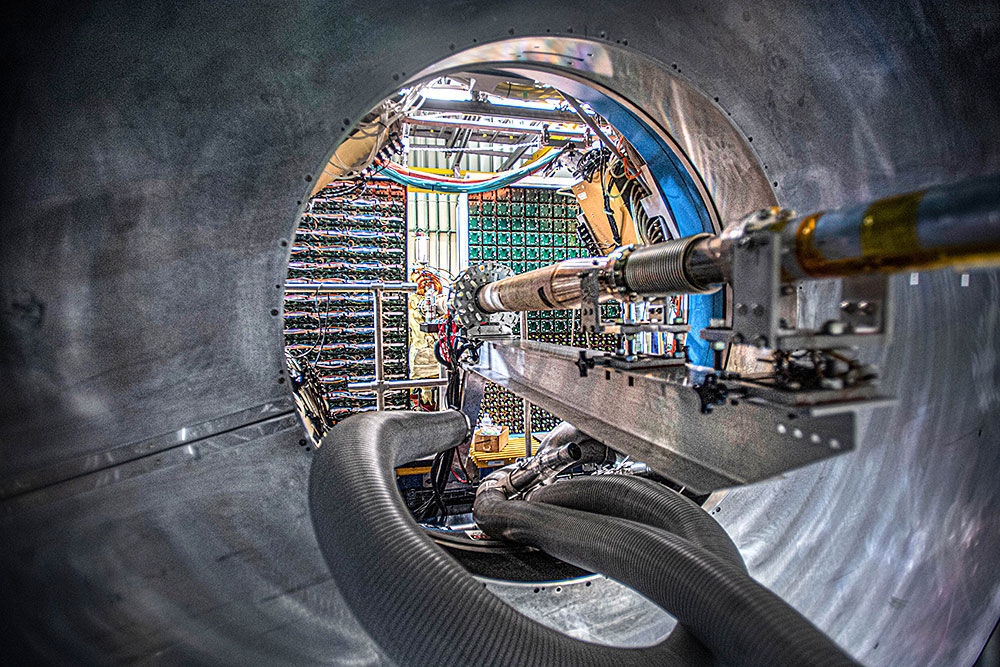 enlarge
enlarge
A view through the STAR endcap magnet at the new calorimeter components installed in the "forward" direction. These components will allow physicists to measure and reconstruct the energy of jets from particles emerging close to the beamline.
Just prior to the start of this year’s run at the Relativistic Heavy Ion Collider (RHIC)—a U.S. Department of Energy Office of Science user facility for nuclear physics research at DOE’s Brookhaven National Laboratory—a team of scientists, engineers, technicians, and students completed the installation of important new components of the collider’s STAR detector. This house-sized particle tracker (the Solenoidal Tracker at RHIC) captures the subatomic debris created when atomic nuclei collide so scientists can learn about the building blocks of matter. The new components will expand STAR’s ability to track jets of particles emerging in an extreme “forward” direction, meaning close to the beamline through which the particles travel as they collide.
Forward jet detection will be important for learning how the internal components of protons and neutrons—quarks and gluons—contribute to the overall properties of these building blocks of matter.
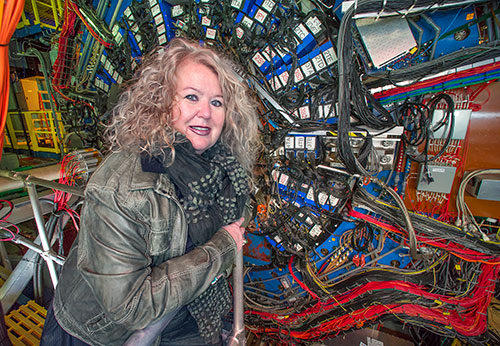 enlarge
enlarge
Brookhaven Lab physicist Elke Caroline Aschenauer is leading the STAR Forward Upgrade project.
“Jets are excellent surrogates for quarks and gluons,” said Brookhaven Lab physicist Elke-Caroline Aschenauer, who leads the STAR forward upgrade. “If you measure the energy of all the particles that make up a jet, then you basically know everything about the quark or gluon that produced that jet during the collision—its energy, direction, and spin.” Measuring many jets will allow scientists to map the 3-D structure of the proton, including the arrangement and spin of the quarks and gluons within.
The new equipment won’t be used for physics measurements until next year’s run of RHIC experiments at high energy. But having the major components—two kinds of calorimeters—installed for this year’s low-energy run gives physicists a chance to calibrate the equipment and work out any kinks.
“We can use this time to get all the data-acquisition systems running, test the read-out channels, and commission our trigger setup”—the system that decides, in a fraction of a second, which collisions to record and which to toss, Aschenauer said.
Separated by space and time
Meeting the deadline for the start of this year’s RHIC run in the midst of a global pandemic was no small task.
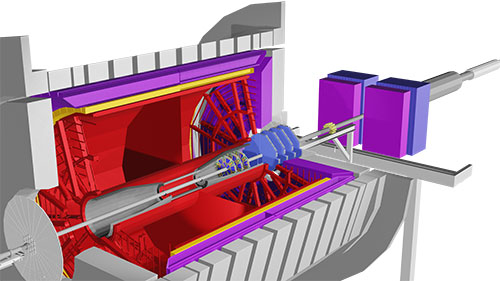 enlarge
enlarge
This schematic rendering of the STAR detector shows the components that make up the forward upgrade. The hadronic calorimeter (violet blocks at the far end of the illustration) and electromagnetic calorimeter (pink blocks closer in) are in place for this year's run. Four "small-strip thin-gap-chamber" disks (light violet) and three silicon disks (multicolor) surrounding the beampipe make up the tracker and will be installed this summer.
“We wanted to have lots of academic ‘users’ of the STAR experiment and their students go to Brookhaven to assemble and install the components, but with COVID, that became very complicated,” said Oleg Tsai, a STAR user from UCLA and the creative mind behind the forward detector design.
Instead, the project moved forward as a collaboration separated by space and time.
“STAR users at universities across the country worked to build and test components with students—including some who lived too far from home to travel during lockdown,” Tsai said.
To maintain social distance, “we naturally split off into morning and afternoon groups,” said David Kapukchyan, a graduate student who helped assemble components at the University of California, Riverside. “We had to leave notes for each other so that each group knew what they had to do for their time in the lab.”
“This experience has given me great insight into how detectors of this size come together and the amount of work it takes to build them,” he added.
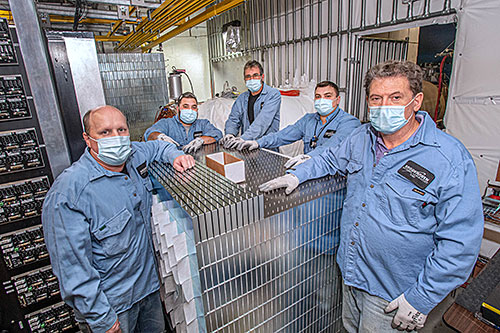 enlarge
enlarge
Some of the Brookhaven Lab Collider-Accelerator Department staff who helped with the installation of calorimeter components at STAR (left to right): Edward Dabrowski, Adrian Timon, Matthew Ceglia, Travis Herbst, and Dennis Carlson.
That satisfied a key goal for Scott Wissink, a STAR user and physics professor at Indiana University, who coordinated the proposal to fund this work through the National Science Foundation’s Major Research Instrumentation (MRI) program, which specifically included support for student participation at the ten universities that made up the project consortium.
“In addition to buying materials and equipment, we also requested funds to support the technical workforce required at the individual universities, and especially to provide opportunities for students to get involved in the testing and assembly of the components,” he said. “This experience will not only ensure that we have the right equipment to carry out the measurements, but will also prepare them to lead the next generation of physics experiments.”
Assisted assembly
“The pieces were produced and delivered from everywhere in the world—Indiana, Pennsylvania, California, Illinois, Texas—even China and Japan. When we couldn’t get toilet paper we were getting scintillators,” Aschenauer noted, describing special plastic that detects particles of light. Then all the pieces—tens of thousands of components—had to be assembled and installed in a Lego-like fashion, layer by layer, she said.
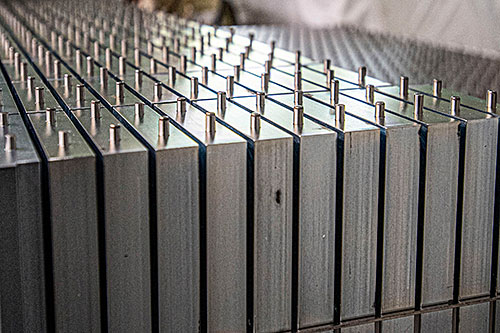 enlarge
enlarge
An array of 520 calorimeter towers, each consisting of 36 steel absorber blocks interleaved with scintillator tiles and the pins that hold them together.
Some students were ultimately able to help.
“I had plans to come to Brookhaven for my doctoral studies before the COVID pandemic hit,” said Erik Loyd, another grad student at UC Riverside. “Though my travel was initially delayed, I ended up moving to New York and quarantining for a month before coming to the Lab to help with installation.”
But with far fewer students available than in normal times, the project leaders turned to technicians in Brookhaven’s Beam & Experimental Services (B&ES) group and the Collider-Accelerator Support (CAS) group for additional assistance.
Brendan Hoy, a member of CAS, noted that his group’s round-the-clock duties typically consist of responding to real time equipment issues—troubleshooting and performing corrective maintenance on things like power supplies and magnets—as well as building, installing, and maintaining various electronic systems around the complex. “The work we do maintaining STAR power supplies and the electronics-centric nature of my regularly assigned duties mapped on to this detector install very well,” he said. “Given the uniquely difficult circumstances that 2020 brought to us all, I found the opportunity to work on a project outside of the normal scope of my role to be a welcome one.”
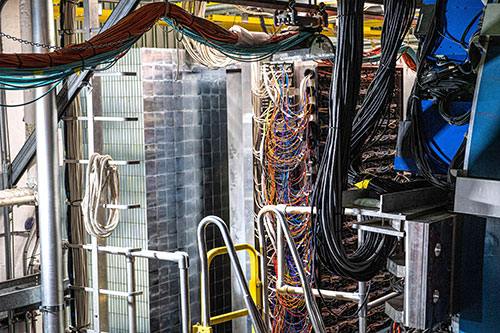 enlarge
enlarge
This image shows one half of the hadronic calorimeter (260 blocks). In the front one can see the electromagnetic calorimeter with all its readout electronics and cables fully installed.
“The Collider-Accelerator Department (CAD) technicians, working with the STAR Technical Support Group, did a great job installing the calorimeters and their support structures,” said Rahul Sharma, STAR’s chief engineer. “The work went twice as fast as originally anticipated, with groups working in alternating shifts in the morning and afternoon to stack multiple layers of the detector blocks. It was a real challenge to try coordinate all this for over three months to complete the installation.”
“We had to overcome many challenges while building these detectors in such a tight location and time frame,” said Travis Herbst, a technician in B&ES. “Due to the limited space, we had to install a temporary conveyor belt that allowed us to transfer almost 10,000 steel absorber blocks weighing 15 tons and 20,000 pins used to hold them together under the beam line so we could build the detectors on both sides.”
Adrian Timon, another B&ES technician, added: “We also had to maintain social distance during all the working hours needed for installing the detector while inspecting and keeping all of the blocks and pins cleaned of debris or deformity, as such defects could cause problems with the detector’s internal structure.”
“The most amazing thing for me was all these minor details that you don’t read about in a textbook when they describe these calorimeters,” said UC Riverside’s Kapukchyan, who also travelled to Long Island for the assembly. “You read about the physics of how particles lose energy and how to calculate it, but all these minor construction details, like how to correctly unspool cables, are left out. Being involved [through all stages of this project] was a great experience for me and will certainly help me in my future endeavors,” he said.
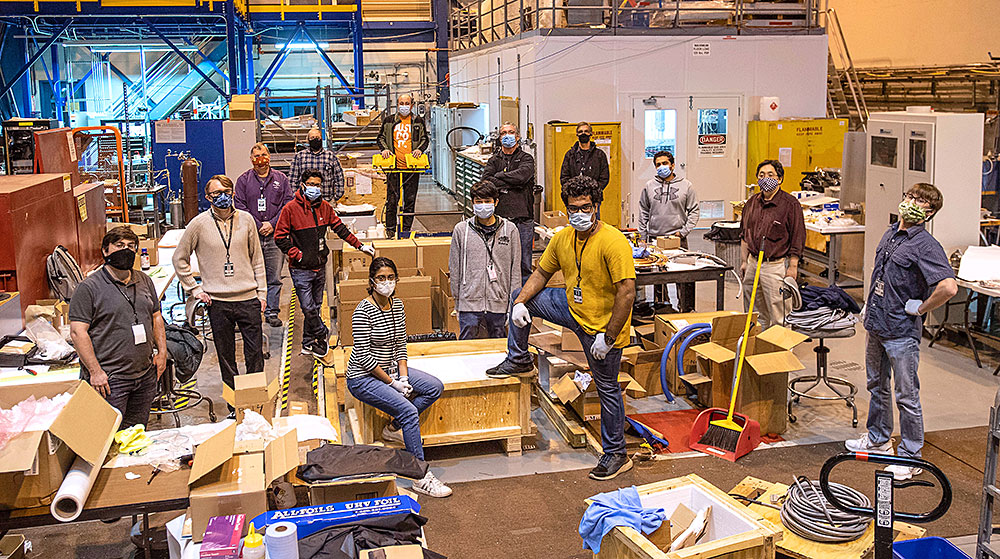 enlarge
enlarge
Students, STAR external users, and technical support group members who participated in the installation in the STAR detector assembly area outside the detector.
Pushing science forward
The now-complete Lego-like calorimeter assemblies will be joined, after this year’s run, by a few additional components—two kinds of tracking detectors for discerning particles with different electrical charges. The whole system will then be ready to collect physics data in the 2022 RHIC run.
Positioned at one end of the STAR detector’s barrel-shaped Time Projection Chamber, the calorimeters and trackers will capture jets that emerge at angles very close to RHIC’s beamline, exiting at that end of the barrel. Studying those particular jets is important because they give scientists access to the quarks and gluons that carry either a very high or very low percentage of the proton’s (or nucleus’s) overall momentum.
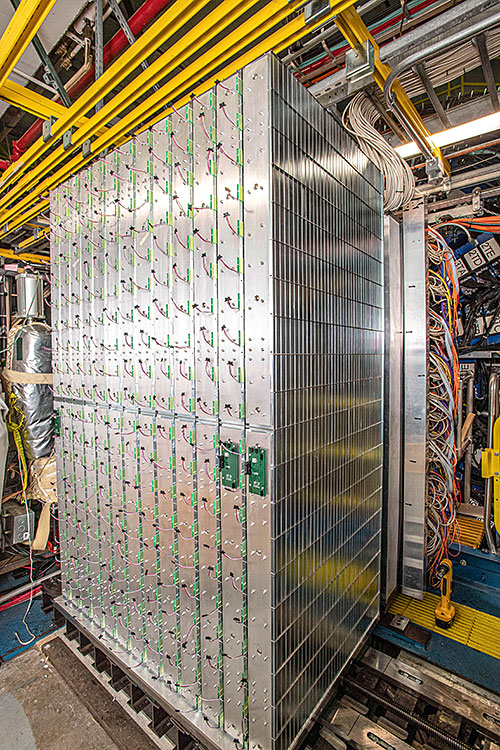 enlarge
enlarge
One half of the hadronic calorimeter, made of 20 x 13 towers, with the first two readout electronics boards installed and the all the signal cables bringing the light from the photon sensors to the readout boards.
Jets produced by scattering off the three main valence quarks that make up a proton carry a large percentage of the particle’s overall momentum. But a proton is much more complex than those three main quarks. Inside there is a teeming microcosm of quark and antiquark pairs that flit in and out of existence. Gluons—aptly named because they glue the quarks together—are even more mysterious. They split and multiply and, at high energies, may completely dominate the structure of the proton. Each of these gluons carries a tiny percentage of the proton’s overall momentum. But because there are so many of them, scientists believe their combined influence plays an outsized role in establishing the proton’s properties. Hence the motivation to study jets generated by these “low-momentum-fraction” gluons.
“These measurements will help us search for evidence that the gold ions we collide at RHIC become dense walls of gluons, and that this saturated state of gluons is responsible for key properties such as proton spin and mass, as suggested by many of the findings we’ve already observed at RHIC,” Aschenauer said.
The measurements will also help lay the groundwork for jet-tracking at the future Electron-Ion Collider (EIC). The EIC is a new state-of-the-art DOE nuclear physics facility to be built at Brookhaven Lab in collaboration with Thomas Jefferson National Accelerator Facility (Jefferson Lab) to expand scientists’ reach into the frontiers of nuclear physics.
“The hadronic calorimeter design we are talking about for the EIC has components that are basically identical to the one that is part of this upgrade, so that part of this project serves as a prototype for future EIC detector components,” Aschenauer said.
The STAR Forward Upgrade receives funding from several sources. University partners’ contributions to the calorimeter system were funded by the National Science Foundation; contributions by scientists and technical staff at Brookhaven Lab were funded by the DOE Office of Science, which also supports RHIC operations. Development of the tracking detectors (yet to be installed) is partially supported by funding from the National Natural Science Foundation of China, the Ministry of Science and Technology of China, the Chinese Ministry of Education, Key Laboratory of Particle Physics and Particle Irradiation of China, the Higher Education Sprout Project by Ministry of Education at National Cheng Kung University.
Brookhaven National Laboratory is supported by the U.S. Department of Energy’s Office of Science. The Office of Science is the single largest supporter of basic research in the physical sciences in the United States and is working to address some of the most pressing challenges of our time. For more information, visit https://www.energy.gov/science/.
Follow @BrookhavenLab on Twitter or find us on Facebook.
2021-17681 | INT/EXT | Newsroom









